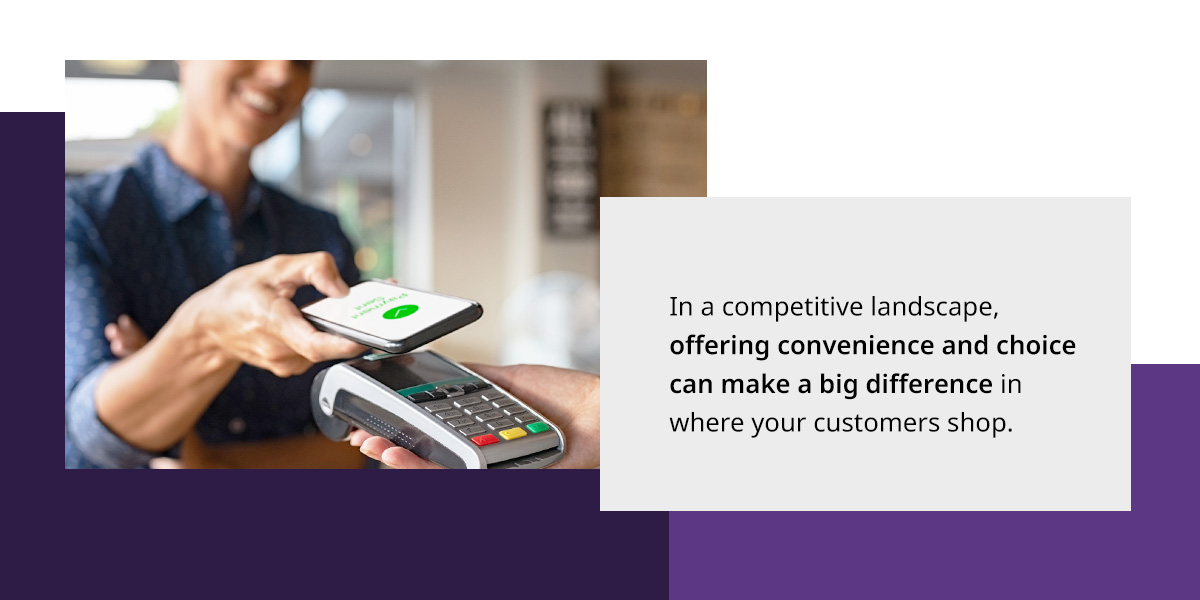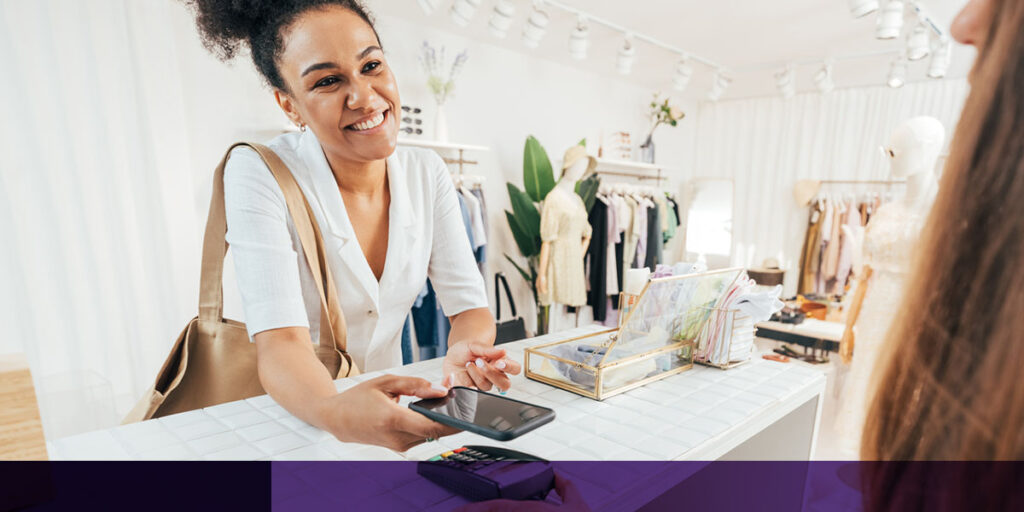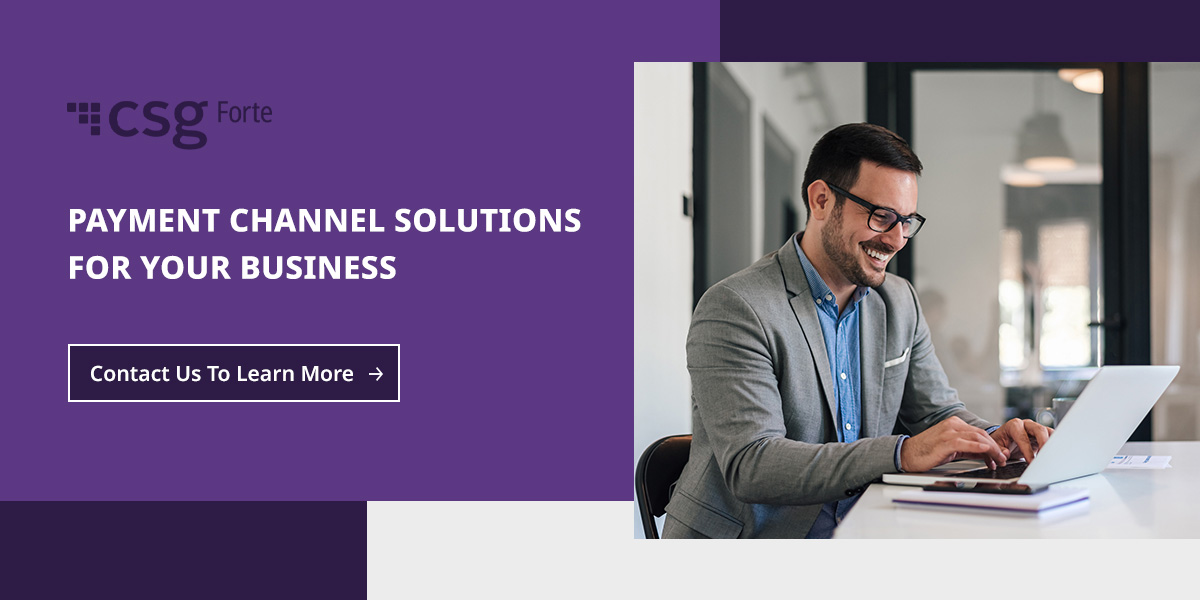What’s a Payment Channel?
Today’s consumers have tons of options when paying for goods and services. From pulling out cash to quickly tapping a phone or credit card near a terminal, payment methods have expanded to include an array of choices, each with its own perks and drawbacks. Offering these different methods of payment—also known as channels—creates benefits for businesses and customers. Before you set them up, you’ll need to know the difference between channels and how to implement them in your organization.
What Is a Payment Channel?
A payment channel is any way a customer might make a payment or anywhere that you, a merchant, might accept a payment. A payment channel includes a payment method, such as a debit card or a bank account, and the technical infrastructure that allows businesses and financial institutions to verify transactions and send funds. The infrastructure might include steps like securely sending card information entered into a website or checking the transaction for potential fraud.
Retail channels are a similar yet distinct concept. Retail channels cover different ways people can shop, like brick-and-mortar stores, catalogs and online shopping sites. Payment channels are generally related to these retail channels but are more specific to how people make payments. They correlate to retail channels but leave some room for overlap.
For example, at a brick-and-mortar retail channel, you might process payments on a physical point-of-sale (POS) system—a cash register—as well as on smartphones or tablets within the store. Your catalog might accept payments by phone but also integrate into an omnichannel approach. Customers could walk into your brick-and-mortar store to pay at the POS, or they could shop the catalog online and pay via online checkout.
Payment and retail channels closely relate to each other. Since you definitely want to create a cohesive, omnichannel experience, it’s essential to consider what payment channels you might implement. Some of the most popular options include:
Physical POS Systems
Most brick-and-mortar stores have a POS of some kind. These systems allow businesses to take in-person payments such as credit and debit cards, cash and checks. A physical POS can use more traditional technologies as a standalone system, but mobile POS systems are also common. A mobile POS uses devices such as smartphones and tablets to process payments, often with attached card readers. This option works well for businesses looking for easy-to-implement tech or for those on the move, such as field service providers.
Phone and Interactive Voice Response (IVR) Payments
Payments made over the phone can come in one of two varieties. The traditional approach involves talking to an agent to communicate payment details and share card information. An alternative to these contact center payments is to use IVR to walk customers through the process without needing to talk to an agent. The customer can enter specific numbers or say certain words to make the payment. Both methods are popular with service businesses and recurring payments.
Online Checkout Solutions
Online checkouts can come in many forms for everything from e-commerce and subscription services to rent and utility bills. They might integrate features for managing shopping carts, storing the customer’s information for next time or setting up automatic payments. Supported payment methods might include credit and debit cards and Automated Clearing House (ACH) transactions. ACH is the system used to electronically transfer funds between bank accounts and process electronic checks in the United States.
Contactless Payments
Many cards now have integrated chips with near-field communication (NFC) technology. A compatible POS system allows customers to tap their credit or debit card to make payments. Digital wallets like PayPal and Apple Pay can also use NFC technology to facilitate card payments and bank transfers. You’ll find these wallets integrated with online checkouts and supported by physical POS systems, which can collect payment data wirelessly from a user’s smartphone or watch.
The Benefits of Multiple Payment Channels

In a competitive landscape, offering convenience and choice can make a big difference in where your customers shop. Credit cards and debit cards are by far the most popular payment methods at the point of sale, but analysts expect digital wallets to become much more common. However, payment preferences can vary widely by industry, geography, customer demographics and other characteristics.
By offering a range of options, businesses and their customers can reap several benefits, including:
A Better Customer Experience
With more choices, customers can make payments how they want. These methods often come with unique advantages. Cash doesn’t have any processing requirements or fees, while credit cards can offer rewards and fraud protection. Online or over-the-phone payments are convenient and fast.
With multiple options, customers can pick the right one for their situation. From a business perspective, a better customer experience from payment channels can make it more likely someone will make a purchase with you or reduce the liklihood that their payment will be late.
More Sales Opportunities
Different payment channels can create new sales opportunities. Taking online payments can help a local shop reach customers worldwide, while a POS could help a storefront business take payments from customers who don’t typically carry cash.
Flexible payment options can also help customers make payments on time, allowing businesses to maintain steady cash flow.
Additional Features
Some payment channels support useful features. For example, online checkout systems can help customers set up automatic recurring payments, which you can’t do with cash payments. Online checkouts also offer branding opportunities. You could even create email or SMS text message payment channels by including a link to an online payment platform in emails and SMS text notifications.
Payment Channel Security and Compliance Considerations
Protecting customer information and meeting regulations is crucial for any organization collecting payments. Most payment channels use different technological infrastructures, so you’ll need to pay attention to security and compliance requirements. Make sure your solutions follow best practices for technology standards and protocols, like end-to-end encryption, tokenization and fraud prevention methods.
Depending on your industry and the payment channels you use, look for solutions that meet the Payment Card Industry (PCI) Data Security Standard (DSS) and the Health Insurance Portability and Accountability Act (HIPAA). Working with a member of the Nacha Preferred Partner Program can help ensure security with ACH transactions, too.
How to Set up Multiple Payment Channels
Setting up multiple payment channels might sound complex, but a merchant service provider and a unified payment platform simplify the process. Here at CSG Forte, we use the Dex Payments Platform, a comprehensive solution for payment processing. Dex integrates with various online, in-person and phone payment systems for simplified management and various tools to meet customer needs.
Your team can integrate this highly customizable platform with application programming interfaces (APIs), or you can work with our experienced team to implement channels for your business. We can also help with hardware requirements.
CSG Forte offers full payment processing support for the following channels:
- Physical POS: We can help build a physical POS solution and supply the tech, including card readers and our Virtual Terminal that turns existing computers into instant workstations. Our POS systems are PCI-validated with point-to-point encryption for extensive security.
- Phone/IVR: Our phone and IVR services come with your own toll-free number and script-building assistance. Touch-tone and speech-recognition technology can help you build a great customer experience. We also have solutions to streamline and secure payments received through your contact center.
- Online payments: Our robust online checkout solution is smart, speedy and stocked with options. Accept credit and debit cards and ACH payments, and allow customers to pay through your app or other platforms through robust APIs.
You can accept both credit cards and electronic checks on any of these channels, and each channel comes with our cloud-based Virtual Terminal for transaction management and our powerful payment gateway services. All of the reports funnel into the Virtual Terminal, so you don’t have to worry about piecing things together on your own.
These payment channels don’t necessarily have to correlate only to retail, as well. For example, government agencies could implement online payments to accept taxes on the web and leverage a POS system for in-office payment collection.
Payment Channel Solutions for Your Business
Whatever your industry, diverse payment channels can transform your approach. Expand options for your customers and your business with simplified payment processing. And what’s easier than setting up all of your channels with one company? Get started with CSG Forte today. Give us a call at 866-290-5400 to see what we can do for you.


